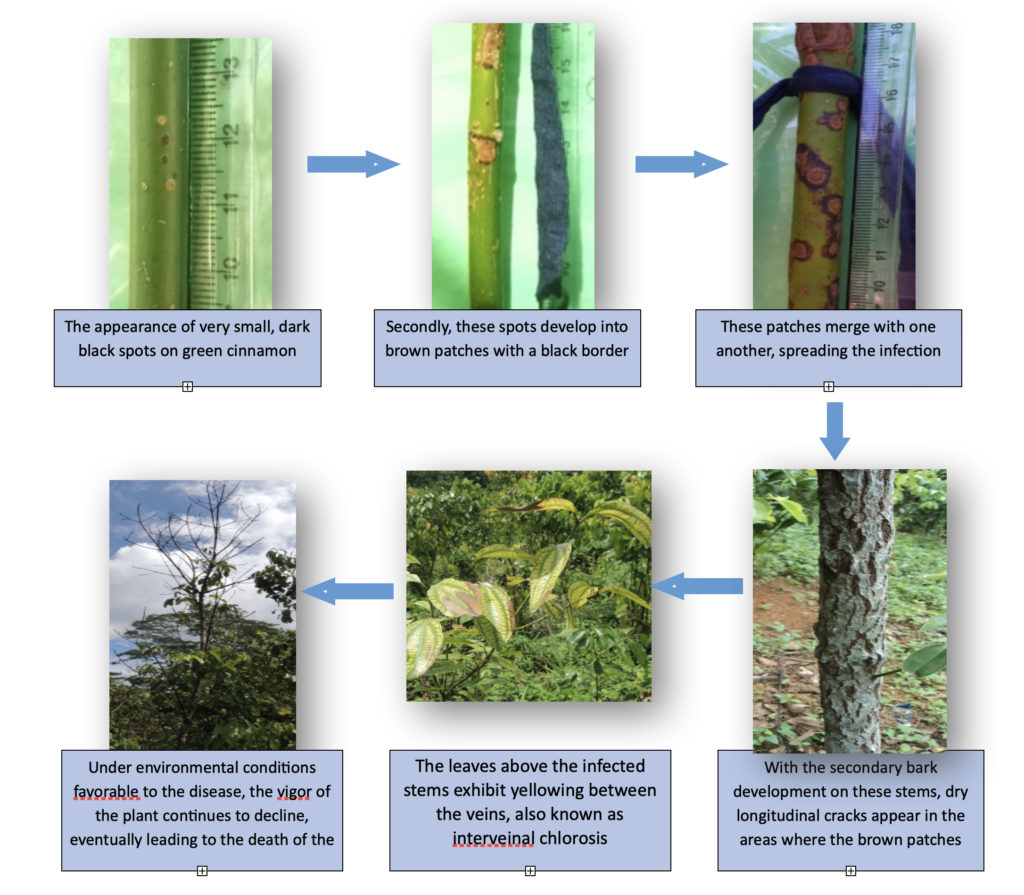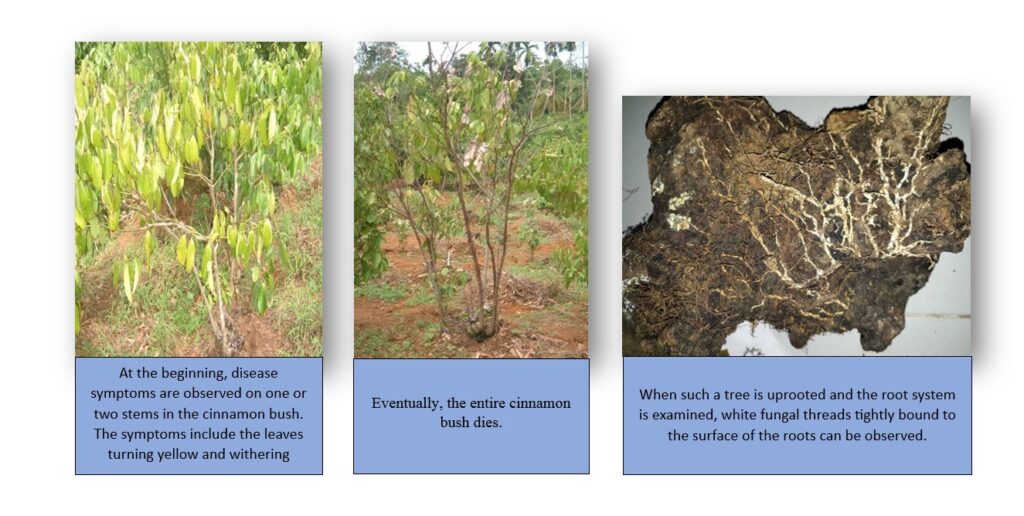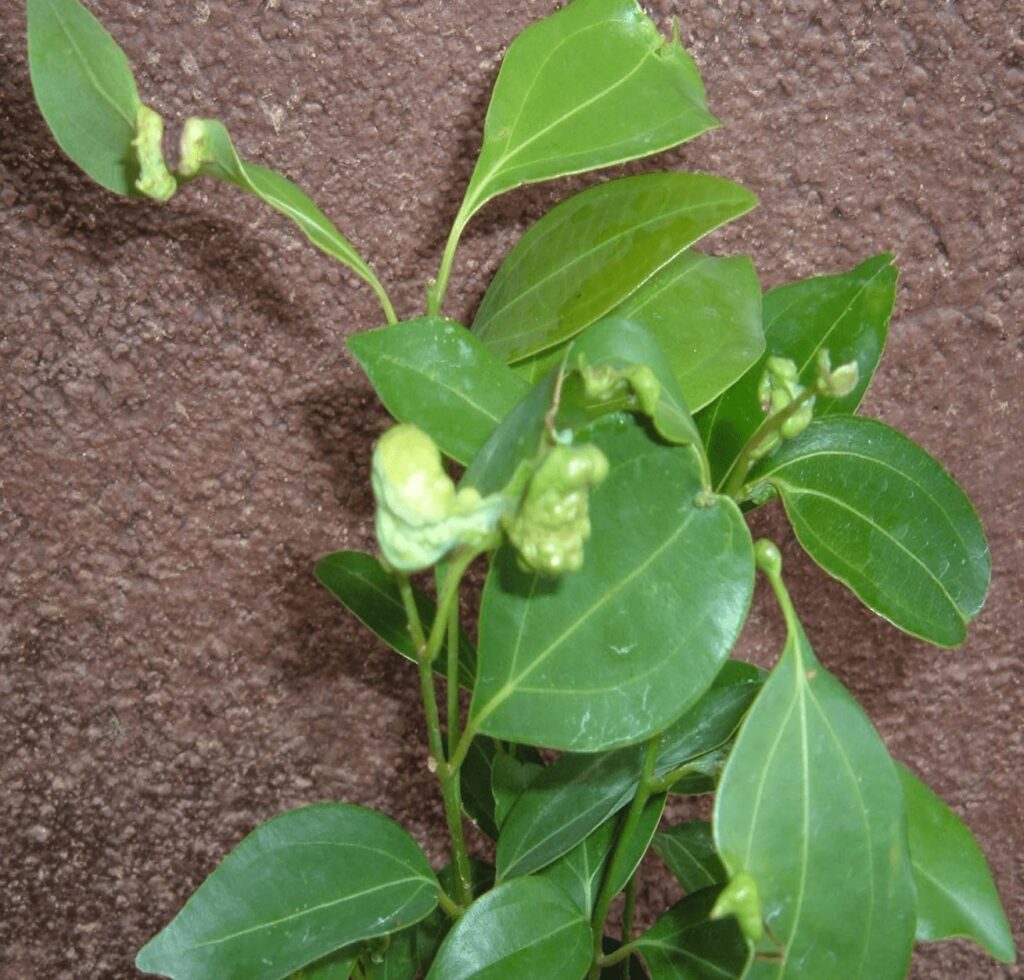Introduction
The crop yield obtained from a cinnamon plantation can be significantly reduced from the maximum potential yield due to crop losses caused by diseases and pests. Proper awareness makes it possible to identify these diseases and pest conditions in their early stages and minimize potential economic loss by following recommended management methods. Under this framework, a combination of agricultural chemicals and good agronomic practices can be utilized.
Common Diseases in Cinnamon Cultivation:
Rough Bark Disease (Pestalotiopsis, Phomopsis, Colletotrichum and Botryodiplodia spp.)
Rough bark disease has spread to almost all cinnamon-growing areas in Sri Lanka. This fungal disease affects the immature bark of the cinnamon tree. Due to the coarse texture in mature trunks,
This condition is also called rough bark. As a result, peeling cinnamon bark becomes difficult, and the quality of the processed bark decreases. However, aside from this disease, the rough texture of the bark can also be caused by the inability to harvest the cinnamon stems at the proper time.

Management:
- Pruning side branches once every 3 months
- Removing and burning diseased branches
- Proper soil nutrient management
- Harvesting stems at shorter intervals (every 4 or 6 months)
- After each pruning, if the disease is present, applying 1% Bordeaux mixture or another copper-based fungicide
- Spraying a mixture containing 10 milliliters of a tebuconazole fungicide (250 grams per liter), diluted in 10 liters of water, on the trunks showing initial disease symptoms using a sprayer
Leaf Blight Disease – (Colletotrichum spp.)
Cinnamon leaf blight, also known as leaf spot, is visible at almost every stage of the cinnamon plant’s life. However, this disease usually reaches economically damaging levels during the nursery stage or sapling stage after establishment in the field. The disease becomes severe during the rainy season, while its spread is minimal during dry periods.

Management:
- Shade Management: Properly managing shade to reduce humidity levels around the plants.
- Isolating Infected Seedlings: Keeping infected seedlings separate to prevent the spread of the disease.
- Fungicide Application:
- Apply a 1% Bordeaux mixture or another copper-based fungicide.
- Spray a solution containing 20 milliliters of Hexaconazole fungicide (50 grams per liter), diluted in 10 liters of water.
- Spray a solution containing 5 milliliters of tebuconazole fungicide (250 grams per liter), diluted in 10 liters of water.
- In mature plantations, as this disease does not cause significant economic damage, the application of fungicides is not essential. Pruning and removing unnecessary shade are sufficient.
White Root Disease – (Rigidoporus microporus)
This fungal disease is commonly seen in cinnamon plantations established on lands previously used for rubber cultivation or in cinnamon plots adjacent to rubber plantations.

Management:
- Maintaining optimal soil moisture: Ensure proper irrigation during the dry season.
- Uprooting and burning infected trees: Remove and burn the infected trees along with their roots to prevent further spread.
- Treatment of remaining roots: Expose the remaining roots in the bush to a depth of about 4 inches and apply a solution of 10 milliliters of tebuconazole fungicide (250 grams per liter) diluted in 10 liters of water. After about half an hour, cover the roots with soil. It is recommended to apply the same treatment to the surrounding trees.
- Isolation of affected areas: If white root disease is widespread, dig ditches to isolate the affected area from other areas.
- Removal of previous crop remnants: When preparing the soil for new planting, ensure to remove any remnants of roots from previous crops.
- Preventive measures in high-risk areas: When planting cinnamon on lands previously used for rubber cultivation or near rubber plantations, mix 10 grams of powdered sulfur into each planting hole a week before planting.
Brown Root Rot Disease – (Phellinus noxius)
Despite its external symptoms being similar to root rot, brown root rot disease (Phellinus noxius) can be accurately identified through an examination of the root system. Infected roots develop a distinctive brownish color, often accompanied by a sand or soil crust. Additionally, clear brownish line patterns can be observed penetrating the inner part of the root.
This disease commonly affects cinnamon plantations during both the early stage of cultivation (2-3 years after planting) and in mature plants. It tends to cause significant damage in shaded areas and soils with poor water drainage.


Management:
- Implement shade management practices.
- Improve soil drainage by installing ditches at appropriate intervals.
- Uproot and burn infected stems along with their roots. Expose the remaining roots in the bed to a depth of 4 inches. Apply a solution containing 10 milliliters of tebuconazole fungicide (250 grams per liter), diluted in 10 liters of water. Cover roots with soil after approximately half an hour.
- Apply the same treatment to plants surrounding the infected area to prevent further spread of the disease.
Stem Cankers
The exact cause of this condition remains unidentified. It is suspected that damage to the cambium layer in cinnamon stems triggers abnormal cell growth, resulting in stem tumors during the secondary growth phase. These enlarged tumors make it challenging to peel the bark during harvesting, thereby significantly impacting the quality of cinnamon bark. This condition often occurs when nitrogen-rich fertilizers are applied in excess of recommended levels.
Management:
- Apply fertilizers strictly according to recommended amounts.
- Harvest cinnamon at the optimal time to prevent unnecessary stem growth.
- Maintain good field hygiene practices to reduce the risk of disease spread.
Swollen Fruit Disease (Exobasidium cinnamomi)
This fungal disease affects cinnamon plants by causing their fruits to swell and deform beyond their normal size. Infected fruits develop red-brown fungal spores, making them visibly discolored. Peeling bark from trees affected by this disease becomes challenging. However, the disease is not extensively widespread.
Management:
- Remove affected branches with diseased fruits at the early stages of infection to prevent further spread of the disease.

Infected cinnamon fruits covered with reddish-brown spores.
Black Sooty Mold (Stenella spp.)
Black sooty mold is a fungal disease frequently observed in cinnamon plants cultivated in shaded environments. It manifests as white, gray, or black spots on the leaf surface, although it typically does not cause substantial economic harm to the crop.

Appearance of White, Gray, or Black Spots on Leaf Surface
Management: Remove shading in the field to reduce the conditions favorable for fungal growth.
Algal Leaf Spots – (Cephaleuros virescens)
This green alga appears as small yellow, orange, or brown spots on the cinnamon leaves. It is occasionally observed in poorly maintained cinnamon fields but is not economically significant.

Algae leaf spots
Common Pests in Cinnamon Cultivation:
Pink Stem Borer – (Ichneumoniptera cinnamomumi)


This is the most disastrous pest for cinnamon in Sri Lanka. The adult female deposits eggs at the base of the stems, and the larvae that hatch out burrow into the base of the cinnamon bush, devouring the internal tissues. This causes emerging shoots to fall off. If this condition persists, the base will decay, disrupting the emergence of new shoots. The larva’s fecal material can be observed as “sawdust” at the base where it has attacked. Another prominent symptom is the growth of new roots above the damaged area.

Management:
- This attack and its spread can be easily prevented by covering the base of the cinnamon bush with soil 3 years after planting when the base starts to expand.
- On sloped land where the above measure is difficult to practice, the base can be covered with a 2-inch-thick layer of clay.
- This attack can be minimized by timely harvesting, preventing soil erosion, and conducting frequent observations of the crop.
Leaf Galls
Leaf Gall Forming Louse – (Trioza cinnamomi)
The plant louse causes galls on the upper side of the leaf. Newly formed galls are pink in color and turn greenish when matured. Only one louse is found inside each gall, sucking plant sap. This attack is prominent during wet and cool climates and is common in the nursery and sapling stages.

Management:
- Can be managed to a certain extent by pruning and removing infested leaves, followed by burning them.
- If the infestation is severe, mix 10 milliliters (two teaspoons) of Abamectin (18 grams per liter) in a 16-liter sprayer tank and spray thoroughly over the entire bush using a flat fan nozzle.
- The flushing stage, when pest infestation begins, is the optimal time to manage this attack.
Leaf Gall Forming Mites – (Eriophyes boisi)
Cinnamon mites cause leaf galls on the underside of the leaf. Nymphs suck plant sap, resulting in non-uniform, large galls that cause significant damage to new flushes, particularly during the nursery stage. This attack is prominent under cool and wet conditions.
Management:
- Prune and remove infested leaves, then burn them.
- In case of severe infestation, mix 10 milliliters (two teaspoons) of Abamectin (18 grams per liter) in a 16-liter sprayer tank and thoroughly spray the entire bush using a flat fan nozzle.

Cinnamon Thrips (Helionothrips annosus)
Sap sucking by adult and nymph thrips on immature leaves causes the leaf tips to appear burnt. Shiny spots, resembling fecal drops of these insects, can be observed under the infested leaves. Severe attacks can lead to leaf shedding, death of apical buds, formation of numerous deformed buds, and even the total death of the plant.


Management:
- At the initial stage of the attack, affected leaves can be handpicked and destroyed.
- Under severe conditions, mix 15 milliliters (1 teaspoon) of Imidacloprid (200 grams per liter) in a 16 liter sprayer tank and spray thoroughly over the entire bush using a flat fan nozzle.
- During the flushing stage, when pest infestation begins, it is optimal to manage this attack with chemical spraying.
- Ensure healthy plants are not kept near infested or severely affected plants.
Leaf Miner – (Acrocercops spp.)
The larvae of leaf miner tunnel through the upper and lower epidermal layers of the leaf. This can commonly be observed in nurseries and newly planted trees.


Management:
- At the initial stage of the attack, affected leaves can be handpicked and destroyed.
- Under severe conditions, mix 10 milliliters (1 teaspoon) of Imidacloprid (200 grams per liter) in 10 liters of water and spray it thoroughly over the entire bush using a flat fan nozzle.
Root Grubs
These soil-dwelling grubs eat the roots of the cinnamon plant, leading to the death of the plants. Mature plants often show resistance to this attack, but immature plants aged 1 to 3 years can suffer significant damage to the plantation.


Management:
- When the attack is severe, avoid clean weeding, as this can expose cinnamon roots and provide easier access for the root grub, potentially killing the plants.
- During planting, avoid using coconut husks and coir dust-like materials inside the planting pit.
- As a chemical measure, mix 5 grams of an insecticide containing Chlorantraniliprole 20% (by weight) and Thiamethoxam 20% (by weight) with 16 liters of water. Use this mixture to drench the root zone and the surrounding soil.
Leaf Eating Caterpillars
Leaf-eating caterpillars encompass various species that typically do not cause significant damage to cinnamon plants.


Management:
- For managing leaf-eating caterpillars, manually picking and destroying the larvae is an effective practice.
Stem Weevil (Alcipes clauses)
This pest damages the immature stem by laying eggs. The emerging larvae and adult stages feed on the immature parts of the stem, and the pupal stage occurs inside the stem. This damage can lead to the death of the apical bud.


Management:
- Manual Removal: Remove adults by hand-picking them from the plants.
- Pruning and Burning: Cut and burn damaged plant parts to prevent the spread of the pest.
- Systemic Chemicals: When damage is severe, consider using systemic insecticides applied according to recommended dosages and application methods.
Leaf Webber
Leaf Webber is a pest that collects a bunch of leaves and constructs a nest-like structure where many larvae can be observed inside.
Management:
- Manual Removal: Remove the nests created by the pest manually and destroy them to reduce the population of larvae.


Vertebrate Pests
When immature stems newly emerge after harvesting, they can be damaged by vertebrate pests such as Barking deer, Chevrotain, Bandicoot rat, Sambar, Squirrel, and Peacock, leading to a decrease in the count of harvestable straight stems.



Management:
- Newly emerged tender stems can be protected by covering them with stem parts left in the field after harvesting.
- Alternatively, these newly emerged stems can be sprayed with a diluted cow dung solution prepared by mixing 1 kilograms of cow dung with 10 liters of water. Optionally, an insecticide with a strong odor can be added to enhance effectiveness.
- Implementing preventive measures such as installing fences, hanging plastic strips in the field, using noise-making devices, setting up electric fences, and deploying crackers can effectively deter these pests.
